 |
Construct version 5.4.4
An agent based modeling framework
|
 |
Construct version 5.4.4
An agent based modeling framework
|
Model that allows agents to add and parse emotions. More...

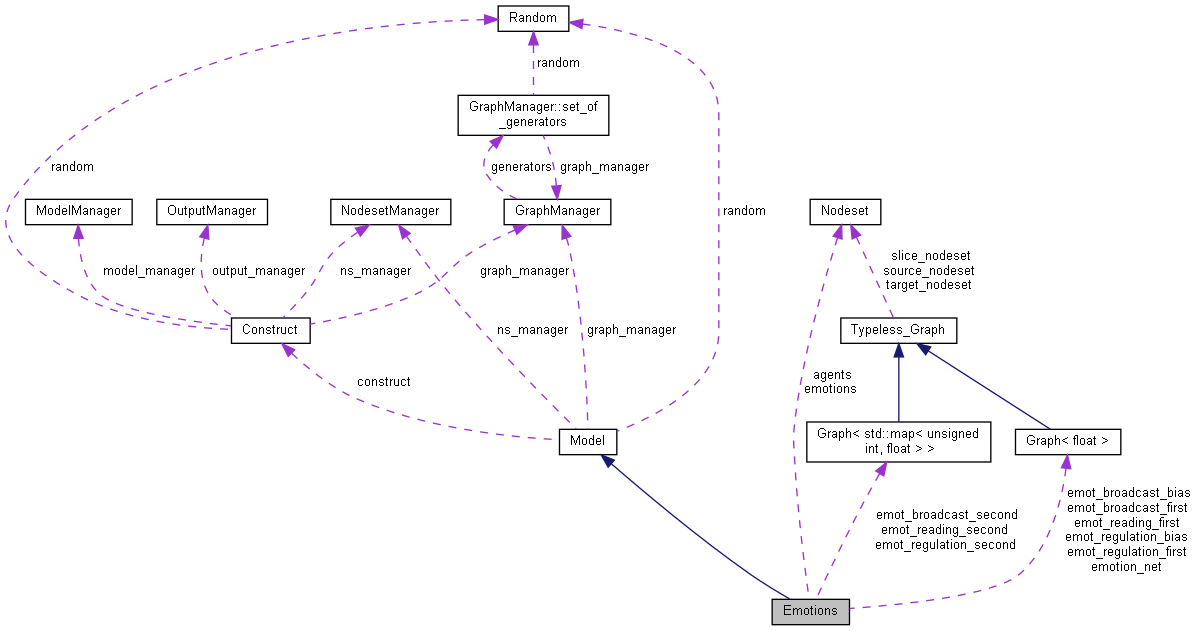
Public Member Functions | |
| Emotions (Construct &construct) | |
| Checks for the agent node attributes "can send emotion" and "can receive emotion" and adds the emotion nodeset's names to InteractionItem::item_names. | |
| virtual std::map< unsigned int, float > | get_emotions (unsigned int agent_index) |
| Determines which emotions to attach to a message. More... | |
| virtual void | attach_emotions (unsigned int sender_index, InteractionItem *item) |
| Takes the output from Emotions::get_emotions ands the corresponding elements to an InteractionItem. More... | |
| virtual std::map< unsigned int, float > | parse_emotions (const InteractionItem &values) |
| Parses an InteractionItem and converts it to a map that contains only values corresponding to an emotion node. More... | |
| virtual void | read_emotions (const std::map< unsigned int, float > &attached_emotions, unsigned int agent_index) |
| Updates the agent's emotions based on the attached emotions. More... | |
| void | update_item_names (void) |
| Adds the names of emotion nodes to InteractionItem::item_names. More... | |
| bool | intercept (InteractionItem &item, unsigned int sender, unsigned int receiver, const CommunicationMedium *medium) override |
| Each message in the queue has some, none, or all emotions attached to it. More... | |
| void | communicate (const InteractionMessage &msg) override |
| Each message is parsed for attached emotions which update the receiver's emotional state. More... | |
| void | cleanup (void) override |
| Each agent self-regulates their emotions to return to their base emotional state. More... | |
 Public Member Functions inherited from Model Public Member Functions inherited from Model | |
| Model (Construct &_construct) | |
| Constructor for all models in Construct. More... | |
| virtual | ~Model (void) |
| Virtual Deconstructor. More... | |
| virtual void | initialize (void) |
| Function called once before any simulation cycles begin. More... | |
| virtual void | think (void) |
| First function called in a simulation cycle. More... | |
| virtual void | update (void) |
| Function called after the think functions in a simulation cycle. More... | |
| virtual bool | intercept (InteractionItem &item, unsigned int sender, unsigned int receiver, const CommunicationMedium *medium) |
| Allows for models to effect change to items created by other models. More... | |
| virtual void | communicate (const InteractionMessage &msg) |
| Function called after the update functions in a simulation cycle. More... | |
| virtual void | cleanup (void) |
| Function called after the Model::communicate functions in a simulation cycle. More... | |
| void | add_base_model_to_model_manager (const std::string &base_model_name) |
| Adds a derived model under the name of the base model and disables the model manager from calling its functions. | |
Public Attributes | |
| const Nodeset & | agents = ns_manager.get_nodeset(nodeset_names::agents) |
| const Nodeset & | emotions = ns_manager.get_nodeset(nodeset_names::emotions) |
| Graph< float > & | emotion_net = graph_manager.load_required(graph_names::emotion_net, agents, emotions) |
| Each link holds the emotional value of each agent for each emotion. More... | |
| const Graph< float > & | emot_broadcast_bias = graph_manager.load_optional(graph_names::emot_broad_bias, 1.0f, agents, false, emotions, false) |
| The base probability an agent attaches an emotion. More... | |
| const Graph< float > & | emot_broadcast_first = graph_manager.load_optional(graph_names::emot_broad_first, 0.0f, emotions, false, emotions, false) |
| The first order emotional dependence on the probability an agent attaches an emotion. More... | |
| const Graph< std::map< unsigned int, float > > & | emot_broadcast_second |
| The second order emotional dependence on the probability an agent attaches an emotion. More... | |
| const Graph< float > & | emot_reading_first = graph_manager.load_required(graph_names::emot_read_first, emotions, emotions) |
| The first order emotional dependence on the deflection from reading an emotional message. More... | |
| const Graph< std::map< unsigned int, float > > & | emot_reading_second |
| The second order emotional dependence on the deflection from reading an emotional message. More... | |
| const Graph< float > & | emot_regulation_bias = graph_manager.load_required(graph_names::emot_reg_bias, agents, emotions) |
| The base emotion-independent dependence on the self-regulation of emotion. More... | |
| const Graph< float > & | emot_regulation_first = graph_manager.load_required(graph_names::emot_reg_first, emotions, emotions) |
| The first order emotional dependence on the self-regulation of emotion. More... | |
| const Graph< std::map< unsigned int, float > > & | emot_regulation_second |
| The second order emotional dependence on the self-regulation of emotion. More... | |
 Public Attributes inherited from Model Public Attributes inherited from Model | |
| Construct & | construct |
| GraphManager & | graph_manager |
| NodesetManager & | ns_manager |
| Random & | random |
| bool | valid |
| If member is false, the model's functions are not called. | |
Static Public Attributes | |
| static constexpr char | emot_itemkey_block = 100 |
| Defines the start of the reserved block of keys for emotions in InteractionItem::item_keys More... | |
Model that allows agents to add and parse emotions.
Agents may attach the emotions of the sender of a messages during the update function. Emotions are added probabilistically based on the agent's current emotional state. Agents then parse the emotions of those that they receive messages from. Emotions of the ego agent is updated based on their current emotional state and the emotions contained in the message. Finally, agents self-regulate their emotions during the clean_up step to either increase or decrease their emotional value.
|
virtual |
Takes the output from Emotions::get_emotions ands the corresponding elements to an InteractionItem.
For each element in the output from Emotions::get_emotions, the key is converted to an InteractionItem::item_keys after adding Emotions::emot_itemkey_block to it and then stored in InteractionItem::values. InteractionItem::item_keys::emotion is then added to InteractionItem::attributes.


|
overridevirtual |
Each agent self-regulates their emotions to return to their base emotional state.
Each agent \(i\) updates their emotion \(n\) by \(E^'_{i,n}=A_{i,n}+\sum_mB_{n,m}E_{i,m}+\sum_{m,g}C_{n,m,g}E_{i,m}E_{i,g}\), where \(A\) is the "emotion regulation bias network", \(B\) is the "first order emotion regulation network", \(C\) is the "second order emotion regulation network", \(E\) is the "emotion network", and \(E^'\) is the updates to the emotion network.
Reimplemented from Model.
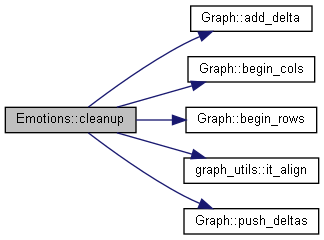
|
overridevirtual |
Each message is parsed for attached emotions which update the receiver's emotional state.
The message is scanned for all emotion items. For each of these items, its emotion index and emotional value pair is added to a map that is eventually passed to read_emotions to update the receiver's emotional state.
Reimplemented from Model.
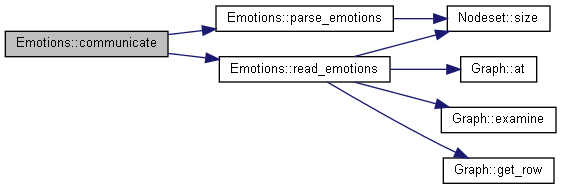
|
virtual |
Determines which emotions to attach to a message.
The equation for calcuating the probability the agent_index \(i\) will attach emotion \(n\) is \(P^{(attach)}_{i,n}=A_{i,n}+\sum_mB_{n,m}E_{i,m}+\sum_{m,g}C_{n,m,g}E_{i,m}E_{i,g}\) where \(A\) is the "emotion broadcast bias network", \(B\) is the "first order emotion broadcast network", \(C\) is the "second order emotion broadcast network", and \(E\) is the "emotion network".
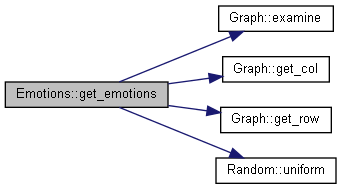

|
overridevirtual |
Each message in the queue has some, none, or all emotions attached to it.
Using the result from get_emotions, each attached emotion is added to the message as its own InteractionItem. Emotion items use the InteractionItem::item_keys::emotion key. This key is added to InteractionItem::attributes. The emotion index is stored using this key in InteractionItem::indexes and the emotional value is stored using this key in InteracionItem::values.
Reimplemented from Model.

|
virtual |
Parses an InteractionItem and converts it to a map that contains only values corresponding to an emotion node.
If the item doesn't contain InteractionItem::item_keys::emotion in its attributes, an empty map is returned. Otherwise, for each element in InteractionItem::values, if the key when converted to a char is greater than Emotions::emot_itemkey_block, That value is added to the returned map with a key equal to item's key minus Emotions::emot_itemkey_block. An assertion is raised if the item's key is larger than or equal to Emotions::emot_itemkey_block + the emotion nodeset's size.


|
virtual |
Updates the agent's emotions based on the attached emotions.
The equation for calcuating the updated emotional value for emotion \(n\)m for the agent_index \(i\) with \(\tau\) being the attached emotions is \(E^{'}_{i,n}=\frac{1}{1+exp\left[ -\sum_mB_{n,m}\tau_m-\sum_{m,g}C_{n,m,g}\tau_m\tau_g +ln\left( 1-\frac{1}{E_{i,n}}\right)\right]}\) where \(B\) is the "first order emotion reading network", \(C\) is the "second order emotion reading network", and \(E\) is the "emotion network".
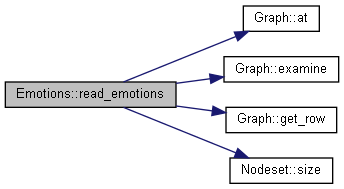

|
inline |
Adds the names of emotion nodes to InteractionItem::item_names.
The names are added at a key equal to the node's index plus Emotions::emot_itemkey_block. Assertion can be raised if a name already exists at a key reserved by the block.

| const Nodeset& Emotions::agents = ns_manager.get_nodeset(nodeset_names::agents) |
summary>
| const Graph<float>& Emotions::emot_broadcast_bias = graph_manager.load_optional(graph_names::emot_broad_bias, 1.0f, agents, false, emotions, false) |
The base probability an agent attaches an emotion.
Dimensions: agent x emotion
This network is a part of the equation for calculating the probability that an agent attaches an emotion to a message they send. The probability agent \(i\) attaches emotion \(n\) is \(P_{i,n}=A_{i,n}+\sum_mB_{n,m}E_{i,m}+\sum_{m,g}C_{n,m,g}E_{i,m}E_{i,g}\) where \(A_{i,n}\) corresponds to links in this network.
| const Graph<float>& Emotions::emot_broadcast_first = graph_manager.load_optional(graph_names::emot_broad_first, 0.0f, emotions, false, emotions, false) |
The first order emotional dependence on the probability an agent attaches an emotion.
Dimensions: emotion x emotion
This network is a part of the equation for calculating the probability that an agent attaches an emotion to a message they send. The probability agent \(i\) attaches emotion \(n\) is \(P_{i,n}=A_{i,n}+\sum_mB_{n,m}E_{i,m}+\sum_{m,g}C_{n,m,g}E_{i,m}E_{i,g}\) where \(B_{n,m}\) corresponds to links in this network and \(E_{i,m}\) is the agent's emotional value for emotion \(m\).
| const Graph<std::map<unsigned int, float> >& Emotions::emot_broadcast_second |
The second order emotional dependence on the probability an agent attaches an emotion.
Dimensions: emotion x emotion x emotion
This network is a part of the equation for calculating the probability that an agent attaches an emotion to a message they send. The probability agent \(i\) attaches emotion \(n\) is \(P_{i,n}=A_{i,n}+\sum_mB_{n,m}E_{i,m}+\sum_{m,g}C_{n,m,g}E_{i,m}E_{i,g}\) where \(C_{n,m,g}\) corresponds to links in this network and \(E_{i,m}\) is the agent's emotional value for emotion \(m\).
|
staticconstexpr |
Defines the start of the reserved block of keys for emotions in InteractionItem::item_keys
When referencing an emotion in an InteractionItem, the node's index is equal to the key in the item minus this member.
summary>
| const Graph<float>& Emotions::emot_reading_first = graph_manager.load_required(graph_names::emot_read_first, emotions, emotions) |
The first order emotional dependence on the deflection from reading an emotional message.
Dimensions: emotion x emotion
This network is a part of the equation for calculating the deflection of an emotion in response to reading an emotional message. Positive deflection increases the emotional value, negative decreases, and a deflection of zero does not change the emotional value. The deflection of emotion \(n\) for agent \(i\) is \(D_{i,n}=\sum_mB_{n,m}\tau_{m}+\sum_{m,g}C_{n,m,g}\tau_m\tau_g\) where \(B_{n,m}\) are links in this network and \(\tau_m\) is the emotional value contained in the read message for emotion \(m\).
| const Graph<std::map<unsigned int, float> >& Emotions::emot_reading_second |
The second order emotional dependence on the deflection from reading an emotional message.
Dimensions: emotion x emotion x emotion
This network is a part of the equation for calculating the deflection of an emotion in response to reading an emotional message. Positive deflection increases the emotional value, negative decreases, and a deflection of zero does not change the emotional value. The deflection of emotion \(n\) for agent \(i\) is \(D_{i,n}=\sum_mB_{n,m}\tau_{m}+\sum_{m,g}C_{n,m,g}\tau_m\tau_g\) where \(C_{n,m,g}\) are links in this network and \(\tau_m\) is the emotional value contained in the read message for emotion \(m\).
| const Graph<float>& Emotions::emot_regulation_bias = graph_manager.load_required(graph_names::emot_reg_bias, agents, emotions) |
The base emotion-independent dependence on the self-regulation of emotion.
Dimensions: agent x emotion
This network is a part of the equation for updating an agent's emotional state each time step. The updated emotional value for emotion \(n\) for agent \(i\) is \(E^{'}_{i,n}=A_{i,n}\sum_mB_{n,m}\E_{i,m}+\sum_{m,g}C_{n,m,g}E_{i,m}E_{i,g}\) where \(A_{i,n}\) are links in this network and \(E_{i,m}\) is the agent's emotional value for emotion \(m\).
| const Graph<float>& Emotions::emot_regulation_first = graph_manager.load_required(graph_names::emot_reg_first, emotions, emotions) |
The first order emotional dependence on the self-regulation of emotion.
Dimensions: emotion x emotion
This network is a part of the equation for updating an agent's emotional state each time step. The updated emotional value for emotion \(n\) for agent \(i\) is \(E^{'}_{i,n}=A_{i,n}\sum_mB_{n,m}\E_{i,m}+\sum_{m,g}C_{n,m,g}E_{i,m}E_{i,g}\) where \(B_{n,m}\) are links in this network and \(E_{i,m}\) is the agent's emotional value for emotion \(m\).
| const Graph<std::map<unsigned int, float> >& Emotions::emot_regulation_second |
The second order emotional dependence on the self-regulation of emotion.
Dimensions: agent x emotion
This network is a part of the equation for updating an agent's emotional state each time step. The updated emotional value for emotion \(n\) for agent \(i\) is \(E^{'}_{i,n}=A_{i,n}\sum_mB_{n,m}\E_{i,m}+\sum_{m,g}C_{n,m,g}E_{i,m}E_{i,g}\) where \(C_{n,m,g}\) are links in this network and \(E_{i,m}\) is the agent's emotional value for emotion \(m\).